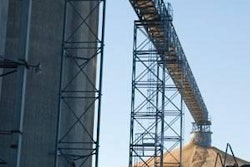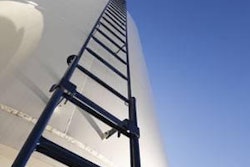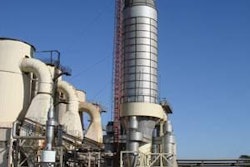.jpg?auto=format%2Ccompress&q=70&w=400)
What a difference a year makes, when your name is Nutreco. Only 12 months ago, this animal nutrition group from the Netherlands was based solidly in Europe as far as its compound feed manufacturing activities were concerned. Group-owned compounding mills at Dutch and Belgian locations operated under the Hendrix label while plants in Spain and Portugal carried the Nanta brand. The change today is North American. Nutreco's acquisition of Maple Leaf Animal Nutrition within the past few months has made it also the largest producer of compounds in Canada.
For the record, the completion of the 345 million takeover that led to the establishment of Nutreco Canada has brought assets including six compounds-producing mills. The trans-Canadian operator, with brands such as Shur-Gain and Landmark, was described as holding 23 percent of the market for animal feeds in Canada and about 8 percent of the dairy feeds business in neighboring New York State.
It has been Nutreco's biggest-yet acquisition in animal nutrition, but chief operating officer Jürgen Steinmann is quick to correct any impression that the Canadian purchase was of a compounds-only business.
"We did not just buy a compounder," he commented in an exclusive interview for this issue of Feed International. "The former Maple Leaf Animal Nutrition or MLAN is much more than a complete feed company. At least half of its volumes are from specialties, meaning premixes, minerals, additives, concentrates and petfoods. In addition to those compounding mills, it has a specialized petfood plant and nine factories for premixes and other specialties. We have bought a market leader that is extremely well-managed and has a wide portfolio of products as well as a good balance for the various parts of Canada which is important, as I regard each of those geographic areas as a different market.
Growth potential
"It has given us visibility not only in Canada, but also in the world because it is a major player of considerable size. We also like the fact that Canada is what I would call a feel-good country. Canada offers good growth potential at a relatively low risk. Some other places may have offered higher rates of growth, but not without much bigger risks."
Financial reports to shareholders for the first six months of 2007 took the Canadian acquisition into account when indicating that the overall feed volume for the group had grown to 8 million metric tons per year. Compounds have represented approximately 5 million tons of this total, says Mr. Steinemann. The stock market statement drew the contrast between the group's current size and the combined figure of 6 million tons it achieved for complete feeds and specialties in 2003. At that time, feed supplied 50 percent of Nutreco's sales. The other half was due to food-chain activities in fish farming and meat. Now, after a string of divestments, the aquaculture is gone and meat is a minority interest so that feed brings in 80 percent of all turnover.
Nutreco generated revenues of over 3 billion in 2006 and chief executive Wout Dekker has reported a 25 percent increase to just under 1.7 billion for first-half 2007.
Organic growth contributed 8 percent and acquisitions 5 percent, with a further 13 percent from higher prices because of more expensive raw materials. The income from continuing operations rose 61 percent on higher animal nutrition and fish feed sales, to 47 million. This included a 49 percent increase from animal nutrition, before exceptional items were taken into account, and an 18 percent gain from the fish feed business.
A breakdown of the figures revealed compound feeds to have given sales of 446.2 million in this period, compared to 499.2 million for fish feeds and 326.2 million for premixes and specialties. From Mr. Steinemann's remarks during our interview, the latter two categories may be where we shall see the group's next moves.
Expansion of fish feed capacity
As he reminded us, a commitment has already been announced to extend salmon-feed producing capacity in Norway in 2008 because of increased demand. Nutreco's fish feeds business Skretting is investing 24 million to expand the Averoy plant in centre-west Norway from 180,000 metric tons/year to 240,000 tons/year by June 2008. It would then mean a combined capability for Skretting's three plants to produce more than half a million tons annually. An additional expansion of 100,000 tons/year is under consideration as a second phase.
For its salmon feeds, Skretting has 15 production facilities in the major fish farming regions in Europe, the Americas, Asia and Australia. In 2006, it produced approximately 1.3 million tons of feed for more than 50 different species of farmed fish. Three-quarters of this volume in extruded dry fish feed was destined for salmon and sea trout.
"We would like to be more in fish feeds in Asia as it is the major growth zone for aquaculture," Mr. Steinemann remarked. "The Asian market for me is split into four segments, comprising the individual countries of China, India and Japan with the cluster of South-East Asia. We are already in Japan with Kirin Feeds and we are proactively interested in looking for further acquisitions within the Asian area. South-East Asia would probably be first on our list, but if the right opportunity arose in China we would not say no.'"
Growth in additives
On the subject of specialties, he is even more expansive. The group is already in additives through its ownership of Dutch feed-acids company Selko and Mr. Steinemann describes the margins available in feed additives as "very interesting." He also points to the group's investments in the sector over the past year as evidence of its interest.
"We are open to having a conversation with more people in the additives business if they would like to talk to us," he declares in answer to a question on possible takeovers. "Our own activities in feed additives have been organised so they now form part of the specialties business unit whereas previously they were distributed throughout the company. It means they have a greater focus than before. A larger involvement in feed ingredients will increase our EBIT margin and we can capitalize on our vast network to distribute them internationally. It is much easier to enter the ingredients market if you are in specialties than if you are a compounder, because of the extra distribution channels you have available to you."
The specialties arm of the group has already undergone a metamorphosis this year, not the least by agreeing to purchase BASF's premixing assets in the eight countries of China, Guatemala, Indonesia, Italy, Mexico, Poland, UK and USA. Except for Indonesia and Guatemala, the acquired businesses will be connected with the local premix and feed specialties activities of Nutreco group member Trouw Nutrition International or TNI. With a stroke, the deal doubles the group's global presence in premixes. Annual sales by TNI now are being projected to pass the 400 million mark.
"When we go further in premixes, we will also be looking in Europe. In Western Europe we want to protect our position as the number one premix producer and to grow both in premixes and in young-animal feeds. An expansion in Eastern Europe is certainly of interest to us, however. The situation there, as in Asia and in North and South America, is that the margin is classically in specialties rather than compounds. The complete feeds are the bulk that generate turnover, but the ingredients and additives and premixes generate the margin.
Outlook for compound feeds
"Do not think that we are somehow against compounds. That is not true at all. Six years ago in the Netherlands we acquired the compounder UTD and demonstrated through merging it with our Hendrix company that there is money to be earned in consolidated markets by becoming bigger. We have reorganized that side again recently. At the end of 2005, the managers of Hendrix were rather assuming that the margin they were used to in past had gone, because of the attitudes of other participants in the market who were prepared to sell at a lower price per ton. But with a reorganization program that we have called ROS 07, we have brought them back to the point where the former levels of margin are once more achievable. It has meant closing two factories over the last 12 months so the capacity of others could be fully utilized. We also introduced a new information (IT) system that has allowed us to save costs. The outlook now is very positive for a business that is mainly involved in manufacturing compound feeds.
"You always need luck in all things, including reorganizations and divestments, but it is also essential to have good timing. Our timing on the plan called Rebalance for Growth' has been right. Even our own shareholders have been a little surprised sometimes not only that we have done exactly what we said we would do, but that we have done it so soon!"



.jpg?auto=format%2Ccompress&fit=crop&h=167&q=70&w=250)











